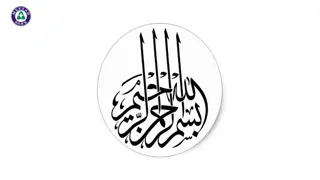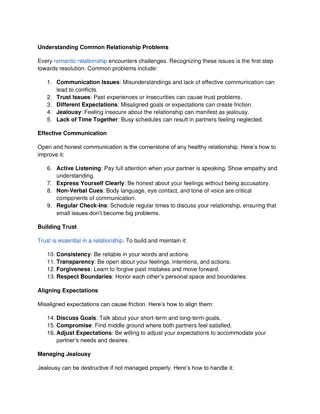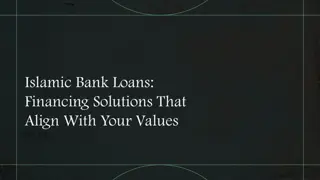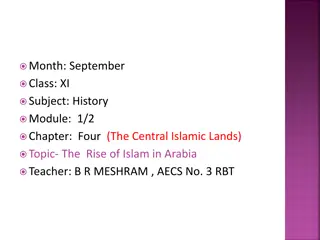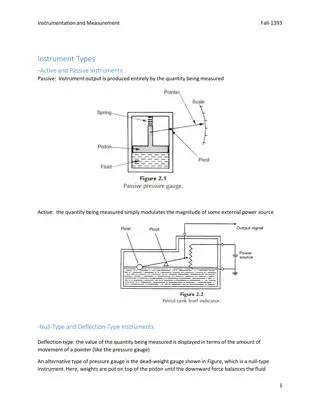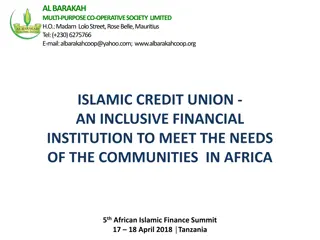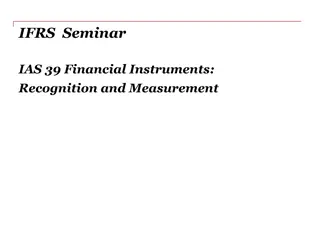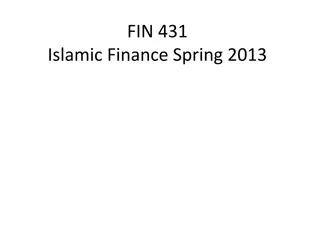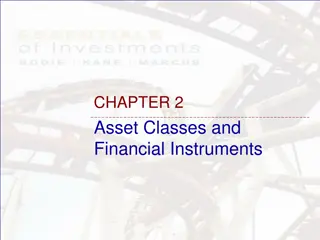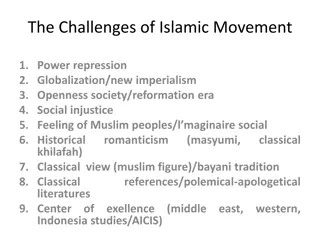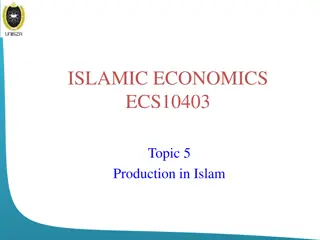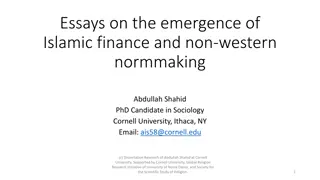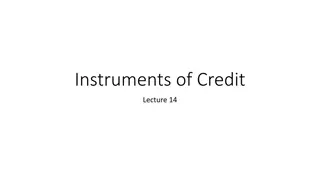Statistical Treatment of Islamic Financial Instruments
Explore the classification and examples of Islamic financial instruments, such as Restricted Mudaraba and Waqf Funds. Understand the scope, process, and economic substance of these instruments, along with their classification in terms of financial assets and liabilities. Learn how to analyze and classify these instruments based on detailed properties and economic sectors.
Download Presentation

Please find below an Image/Link to download the presentation.
The content on the website is provided AS IS for your information and personal use only. It may not be sold, licensed, or shared on other websites without obtaining consent from the author.If you encounter any issues during the download, it is possible that the publisher has removed the file from their server.
You are allowed to download the files provided on this website for personal or commercial use, subject to the condition that they are used lawfully. All files are the property of their respective owners.
The content on the website is provided AS IS for your information and personal use only. It may not be sold, licensed, or shared on other websites without obtaining consent from the author.
E N D
Presentation Transcript
Official Blue: Unclassified Statistical treatment of Islamic Finance Classification of Islamic financial instruments SNA Webinar, 16 December 2021 Michael Lyon, 16 December 2021
Islamic financial instruments: scope and process Scope Review Islamic financial instruments previously considered in existing studies : IMF Monetary and Financial Statistics Manual 2000 Information Note on Islamic Finance by the Advisory Expert Group on National Accounts, 2020. Existing examples Qard, Wadiah, Amanah / Mudaraba / Sukkuk, etc. In total, 28 separate financial instrument categories listed (Annex B, Annex C) New examples: Waqf Funds; Hajj Funds Process Understand the financial instrument. See: AAOIFI, AEG, MFSM 2000, online search, published documentation Analyse the economic substance of the financial instrument in terms of the SNA 2008 and BPM 6 Manuals. Recommend the appropriate financial asset / financial liability classification. This will depend on the detailed properties. Also consider Type of property income Economic sector of IFI institutions Official Blue: Unclassified
Islamic financial instruments: three examples 1. Restricted Mudaraba Existing financial instrument, so this is covered in Annex B (tables) and Annex C (diagrams). Official Blue: Unclassified
Annex B presentation: Restricted Mudaraba (example) Instrument Description National Accounts External Sector Statistics Restricted mudaraba is where an investor restricts the manner as to where, how, or for what purpose the funds are invested. No mixing of funds is allowed from other sources to ensure proper management and accountability of the funds. The IFI manages the restricted mudaraba either as mudarib who engages in risk-sharing or as wakil who acts purely as intermediary for a fixed fee and not participate in the investment results. Restricted Mudaraba FA: Other deposits (F29) or Equity (F51) FA/IIP: Other investment: Currency and deposits: Other deposits or Portfolio investment: Equity Income: Interest and similar returns (D41) or dividends (D421) Income: Primary income: Investment income: Other investment: Interest and similar returns (D41O) or Portfolio investment: Dividends (D42P) (more ) Restricted Mudaraba that are held on- balance sheet of the IFI should be classified as Other Deposits (F29). Restricted Mudaraba that are held off- balance sheet should be treated as equity. Official Blue: Unclassified
Islamic financial instruments: three examples (continued) 2. Waqf Funds (new example) Historically, a 'Waqf' is the endowment of a property for a charitable purpose. A 'Waqf Fund' is a modern method for donors to invest in Waqf fund units for a specified charitable beneficiary. Waqf Fund terminology relates to collective investment schemes ('units', 'investments', etc.) But economic substance is that the Waqf Fund investment is a donation. The donated funds are managed as an endowment fund by a dedicated fund manager. The beneficiary is the charitable project. Classification: Initial donation is a current transfer (D75) imputed to the beneficiary. Beneficiary has an 'other equity' (F519) claim on the assets of the Waqf Fund (S126). Fund manager of the Waqf Fund is a 'captive financial institution' (S127), because it acts exclusively for the beneficiary. Official Blue: Unclassified
Islamic financial instruments: three examples (continued). 3. Hajj Funds (new example) Enable pilgrims to undertake long-term Shariah-compliant saving in order to finance a Hajj pilgrimage. The Hajj Fund undertakes primarily a financial activity (long term saving) It may also provide travel, accommodation, other related services. In some countries, government-supported entities or public corporations promote access to Hajj pilgrimage If the magnitude of any public subsidy is significant, it may not meet the criteria for a 'market producer'. Classification: If the Hajj Fund meets the conditions for a Financial Corporation (including: it is a market producer), and savers bear the collective risks and rewards of the investment in financial securities, then the Hajj Fund should typically be classified to non-MMF investment funds subsector (S124). Official Blue: Unclassified
Islamic financial instruments: conclusions It is usually possible to propose a satisfactory SNA / BPM classification for the considered Islamic financial instruments. But sometimes it is more difficult. There is not always an exact relationship between the Islamic financial instrument and the recommended SNA / BoP classification. The appropriate classification will depend on the actual characteristics of the financial instrument, not simply its formal terminology. New financial instruments will arise as Islamic finance evolves further, so the recommendations cannot be exhaustive. Debt is defined in SNA / BPM as zero residual economic claim. (Note that in SNA / BPM, D41 'interest' is the only form of property income that arises from deposit, loan and debt securities. GN proposes that D41 be renamed 'interest and similar returns'.) Official Blue: Unclassified
Islamic financial instruments: conclusions The GN recommends a decision tree for classification. Possible criteria: What form of institutional unit is represented by the recipient of the finance? An equity classification will only be possible for an entity that is a corporation. Is the financial instrument designed to provide a profit that has a comparatively high reliability as to its magnitude? Whether or not the financial instrument is recorded on the balance sheet of the Islamic Financial Institution. Whether or not the investment account holder has an investment-like claim on ventures or funds offered by the issuing institution (and hence the venture/fund has institutional unit type behaviour). Whether or not the investment account holder has a claim on the residual value of the issuing institution. Whether the lender is the supplier of the goods or services being financed, which would determine a trade credit or loan classification. Whether the financial instrument provides negotiable securities, for example in the form of participation term certificates. Whether equity holdings exceed the 10 per cent threshold for foreign direct investment. Whether an existing foreign direct investment relationship already exists. Official Blue: Unclassified
Questions for Global Consultation Classification of Islamic financial instruments and corresponding investment income Do you agree with the suggested classification of Islamic financial instruments contained in annex B using the slotting-in approach from an economic statistics perspective and that this approach is capable of future application if and as Islamic finance evolves (issue 4.1)? Do you agree with the recommendation to construct a decision tree for inclusion in a compilation guide that would help facilitate future classification decisions (issue 4.2)? Official Blue: Unclassified
Thank you. {To next presentation} Breakout subtitle Official Blue: Unclassified



